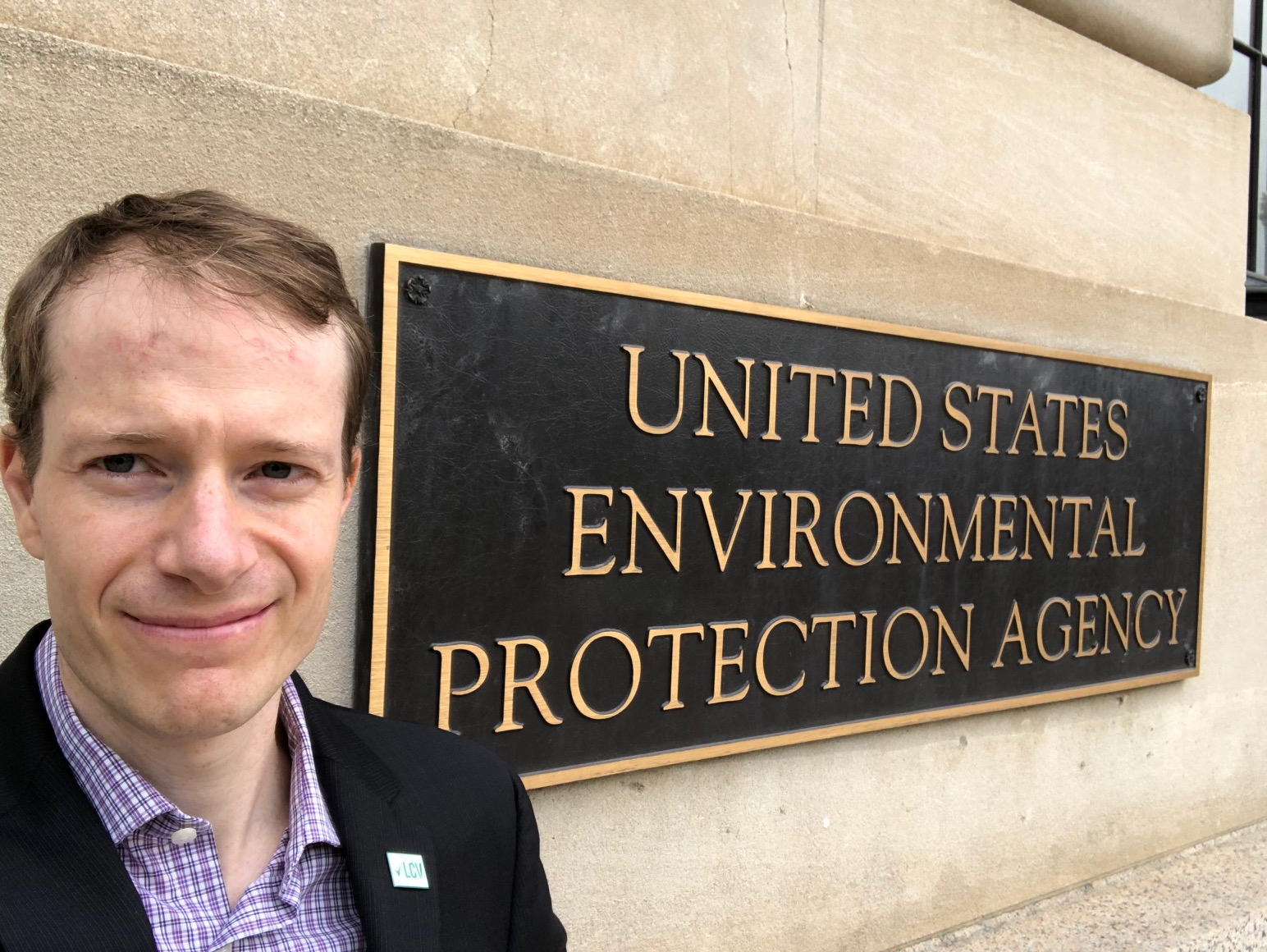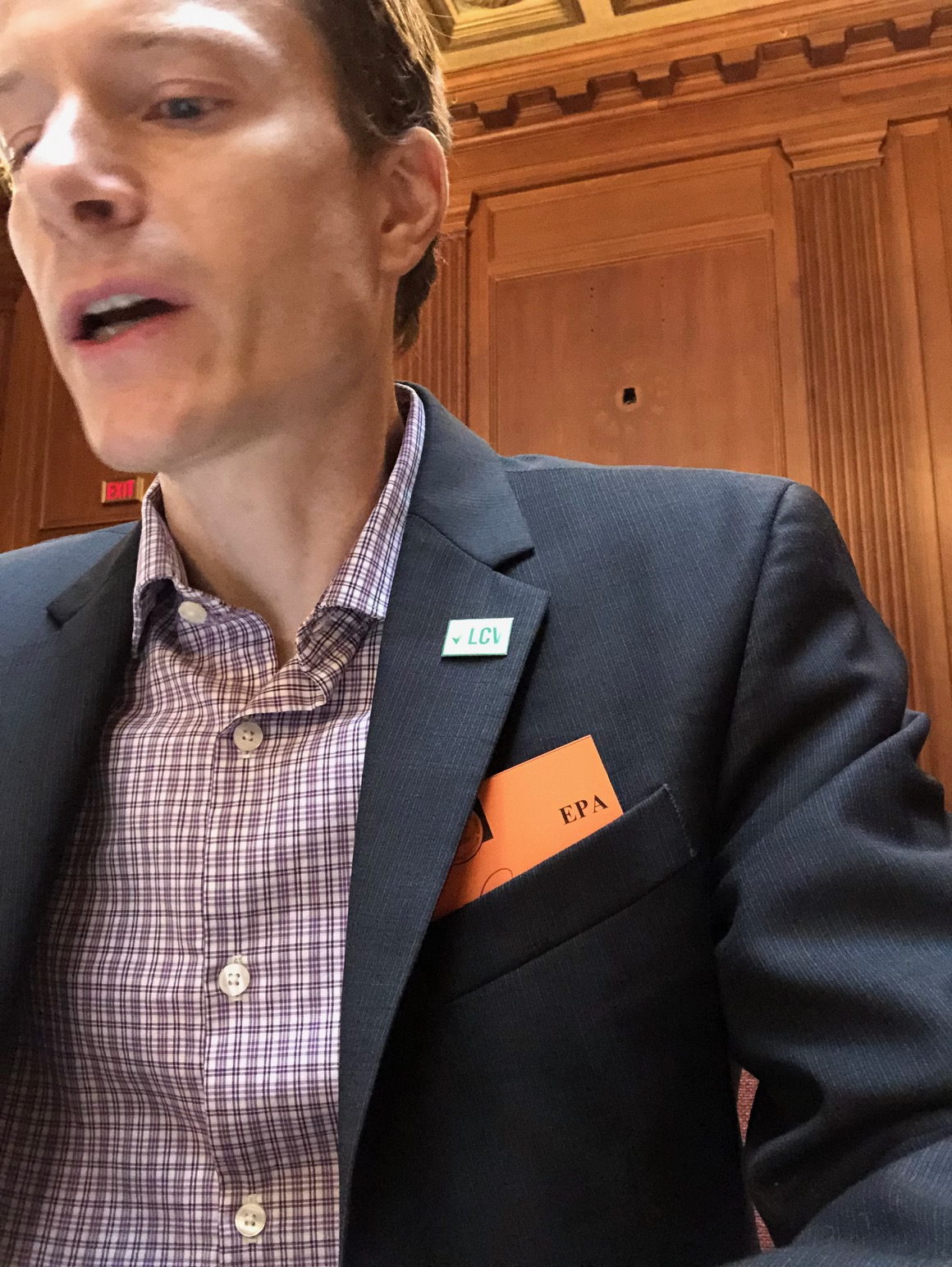Good Climate News this Week: Rules to Cut Pollution, an Offshore Wind Transmission Plan, Emissions Reduction in the EU, and More!
Apr 15, 2024
LCV’s Legislative Director Matthew Davis testified before the EPA today in strong opposition to the agency’s proposed rule on the ‘reclassification of major sources as area sources’ – wonk-speak for a proposal to remove limits on toxic air pollution. The rule would allow major sources of air pollution to comply with weaker emissions standards than are currently enforced and could put a lot more toxic pollution into the air our children breathe. The move, Davis said, is “a gift to big polluters,” from the former head of the EPA’s air quality office Bill Wehrum who resigned in disgrace amid multiple investigations into ethics violations. Wehrum used to be a lawyer and lobbyist for the oil, coal and gas industries. Davis called on the EPA to, “drop this dangerous proposal and get back to its stated mission of protecting public health and the environment.”
Read Matthew Davis’ full testimony below:


Testimony of
Matthew Davis, MPH, Legislative Director, League of Conservation Voters
on
August 15, 2019
for
Proposed Rule: Reclassification of Major Sources as Area Sources
Under Section 112 of the Clean Air Act
Docket Identification No. EPA–HQ–OAR–2019–0282
My name is Matthew Davis, and I’m here today as the Legislative Director at the League of Conservation Voters, or LCV. LCV has more than 2 million members spread across the country, and we work closely with a network of 30 state partner organizations. At LCV, we believe everyone has a right to clean air, water, lands and a safe, healthy community. I also happen to be a former EPA health scientist who spent seven years helping develop air regulations that protect public health.
The EPA’s proposed rule on the reclassification of major sources as area sources, which would eliminate the decades-old policy known as “once in, always in,” stands in direct conflict with LCV’s core values and, indeed, the stated mission of the EPA to protect public health and the environment.
This proposal may be clouded in regulatory wonk-speak, but make no mistake, this is a gift to big polluters from the ethically compromised former EPA Office of Air and Radiation Assistant Administrator Bill Wehrum at the expense of children’s health and front line communities. This proposal would allow large polluters to emit more of the most toxic air pollutants – hazardous pollutants like dioxin, arsenic, lead, manganese, benzene, toluene, formaldehyde, and ethylene oxide, to name a few. These chemicals are associated with numerous types of cancer, neurological and developmental problems, and asthma, among other diseases, and worsen air quality wherever they are pumped skyward. A plain language translation of this proposal might read: the Big Rollback of Toxic Air Pollution Protections, or #PollutersOverPeople episode 5, or Make our Air Gross Again.
Currently, when major air polluters reduce their potential to emit individual hazardous air pollutants below 10 tons per year, or the sum of all their hazardous air pollutants below 25 tons per year, the facilities must continue to meet the strong emissions standards required of these major polluters by the Clean Air Act. Smaller polluters have “lesser controls or no controls at all”, according to a 1995 EPA memo. And these smaller facilities are primarily policed by state and local governments – all cash-strapped and some more attentive than others. This proposal would let those larger facilities be treated as smaller polluters; they could turn off their pollution control devices or reduce their use, pumping out more pollution per hour, so long as the yearly total stayed under the thresholds.
Technical expert or not, it’s intuitive that emissions standards matter. Total yearly numbers belie the immediate negative effects from ozone and particle pollution spikes on peoples’ lungs, particularly children with asthma. And your chances of developing cancer do not change noticeably when a facility emits nine instead of 11 tons per year of ethylene oxide, for example, particularly if you live nearby or downwind. The EPA has done inadequate analyses of the effects of this proposal, given the scope and potential health consequences. This is particularly glaring given the potential adverse health effects for children and those living in environmental justice communities, two groups still protected by Executive Orders 13045 and 12898, respectively. I believe this proposal fails the letter and spirit of both Executive Orders, whose requirements it clearly should trigger, and the Clean Air Act.
In college, I volunteered alongside community leaders in Chester, PA as they fought against the construction of a polluting soil remediation facility. This community bore the brunt of air and water pollution from one of the country’s largest trash incinerators, a county-wide sewage treatment plant, a coal-fired power plant, a pulp and paper mill, and a medical waste incinerator. And it was no accident that this predominantly Black community — in which a third of residents lived below the poverty line — was saddled with living near these highly polluting sources. Systemic racism and injustice shaped city planning and facilities’ permitting, exposing families in Chester to unacceptable risks to their health. This environmental racism is not fair, and this proposal would double down on that environmental racism instead of working towards justice.
We’ve heard from LCV members across the country on this issue. Pam shared with us: “As a rural Louisianan who lives along the Mississippi in ‘cancer alley,’ I am aware constantly of threats to our air and water perpetrated by a variety of methods from those too greedy or stupid to care. My parents have left the Baton Rouge area …”
And Gina wrote: “I live in Southwest Detroit, very close to Marathon oil refinery. Marathon oil has gotten worse in terms of polluting. They say they are burning off the impurities. But this is at my community’s expense. … it’s time for this pollution to stop immediately.”
It is unacceptable that this rollback would have disproportionate and severe health impacts on communities of color – people like Pam and Gina, who are already more likely to be exposed to dangerous air pollution at higher rates
I strongly encourage the EPA to drop this dangerous proposal and get back to its stated mission of protecting public health and the environment.
Thank you for this opportunity to offer comment.